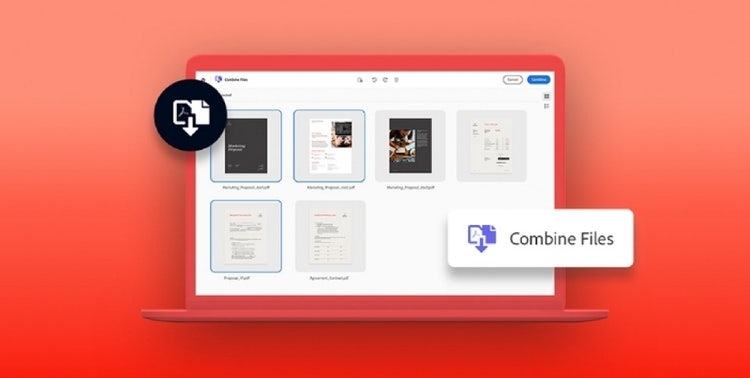ADOBE ACROBAT
How to write a project proposal in 4 steps.
Build a successful proposal step by step with Adobe tools.

What makes a good project proposal?
A project proposal is a document that:
- Explains the project process
- Identifies key stakeholders and audience members
- Covers crucial project details from timelines to budgets
Think of it as a project plan that showcases the path to success that any approver needs to see.
What is a project proposal?
A project proposal is a document that outlines the plan for the project and persuades stakeholders that the project deserves their support. Project proposals appear in a wide variety of contexts. Whether you’re in academia, marketing, hospitality, education, construction, finance, manufacturing, health services, or another industry, you will likely encounter or help create a project proposal.
A well-written proposal can turn into a contract once it has been accepted because it provides the particulars of financing, deliverables, or other relevant terms of work to be completed or services to be rendered within an expected timeframe.
Reasons to write a project proposal.
Many project proposals are written to obtain financing or other resources, but you might also write one to propose a joint venture, demonstrate leadership, build excitement, get more people involved, or show your audience that you’re prepared to begin work.
For example, if you’re writing a research proposal, you might be a student or a professional researcher who needs to show advisors, colleagues, or funding organizations that your research is worthwhile. If you’re a fashion designer, you might write a proposal to a retailer to demonstrate that your products will fit with their brand and benefit their bottom line. If you’re the director of the marketing department, you might need to write a marketing proposal for your company’s executives to outline the plan for the year.
In any context, a proposal is a persuasive document designed to convince your audience to take some kind of action. Even if you’re the one who will carry out the project, you’ll be more successful when the proposal is focused more on your audience than on yourself. Provide a solution to their problem, not to yours. Focus on their long-term goals, not yours.
A written proposal shows that you’re serious and prepared, and it forces you to plan ahead by thinking about all the particulars of a project from start to finish. You’ll need to make sure that it’s written and designed nicely, but you won’t be ready to do that until you’ve put in the work to plan and research the content.

What are the different types of project proposals?
Although project proposals can take different forms depending on the industry, they usually fall into two main categories — they can be either solicited or unsolicited.
A solicited proposal just means that it is written in response to a request for proposal (RFP). Many businesses and organizations send out RFPs to solicit services from other professionals. They have a problem to solve or work to get done, and they want to find out who can do it best. Writing a solicited proposal is convenient because you can find most of the information you need in the request, which should specify any requirements for tools, products, and deadlines.
An unsolicited proposal, on the other hand, can be written even when the organization is not actively seeking proposals for a specified problem or service. That means you have to take the initiative to create a relationship with someone from the organization, to get your proposal in the right hands, and to do a little extra research to understand how your proposal can benefit your audience.
One advantage to writing unsolicited proposals is that you’ll have less competition, or no competition. However, if they’re not actively seeking proposals, they might not be immediately ready to provide funding or to approve a new project. That means you’ll need to be especially persuasive and carefully outline the problem you want to solve. An unsolicited proposal needs to be carefully developed, but it doesn’t need to be formal. It can even be an email.
Whether solicited or unsolicited, find examples of successful proposals in your industry. Learn what kind of formatting and particulars your audience expects.
Beyond those two major categories, you might be writing to propose continued work, to renew a project, to acquire more resources, to offer consulting, or carry out research. Additionally, you may write a nonprofit grant proposal or to obtain funding or a sponsorship. Other types of project proposals are written to obtain educational funds, or business proposals for freelance work, or contract work — such as building a website or a marketing campaign.
You might need to write a proposal to provide services in property management, product distribution, or legal services. Each type can include different sections or use different terminology, but any proposal will usually include a few core components. After writing your proposal, easily proofread, review or edit a PDF version of your work with Adobe Acrobat before sending it to stakeholders.
What is a project proposal composed of?
Whether it’s a printed report or a slide deck, the proposal should include a table of contents to make it easy to navigate and to give your audience an advanced look at the direction it's headed. Even a less formal email can include a sentence summarizing the contents. The elements should include:
An executive summary or an abstract.
However it’s labeled, summarize your plan and its purpose as briefly as possible — in no more than a sentence or paragraph, depending on the size and complexity of the proposal.
A problem statement.
Outline the problem that needs to be solved and provide any relevant background information or context.
A proposed solution.
You can also call this section “project objectives.” Before jumping into the particulars, state exactly what your project is and explain its purpose in response to the problem.
Evidence.
At this point, you’ll need to provide some evidence that your proposed solution is going to work, and you might need to provide multiple additional sections. Depending on your topic, they will vary. Common information to provide includes methodology, tools, and qualifications.
The plan.
Here is where you map out how it’s all going to happen. List deliverables. Provide a timeline. Establish pricing. Explain how you will carry out your proposed solution. Be specific and concrete, with just enough detail to be persuasive.
Signatures.
If you’re successful, the proposal can be immediately transformed into a contract. In addition to your team members’ signatures, create a proposal signature page to provide a place for your audience to sign to indicate their approval.
Three pillars of good project proposals.
No matter the type of project you’re working on, it’s good to know the process of pulling together the right pieces for writing a proposal that conveys the right information. Knowing the ropes will dramatically improve your chances of getting the project approved, especially when you’re working in a professional or academic environment.
Before you actually start outlining and writing, consider three important questions before doing all the necessary work to get your project off the ground.
Pillar 1 — Who is your target audience?
It’s essential to understand who you are writing to for approval when creating a proposal. Knowing your audience will give you a framework for your document. Ask yourself these questions about your audience, team members, and decision makers:
- How familiar are they with the project or problem?
- What do they already know?
- What do they not know?
- What do they want to hear? How will you get their buy-in?
- What do they think project success looks like?
Considering the knowledge levels, expectations, and backgrounds of the audience you are writing for will go a long way toward success.
For example, if your audience has a lot of technical knowledge on the topic, they might expect technical details. If, however, the people giving approval have only basic understanding — perhaps they’re board members with a background in a different industry, or they’re looking for contract work in an area outside their expertise — you will need to be especially careful to avoid jargon and to translate industry language into more general terms.

Pillar 2 — What is the problem you’re trying to solve?
A good project proposal is framed in terms of a problem and a solution. You might have an exciting idea for a fun or interesting project, but if it doesn’t solve a problem for your audience, they won’t be able to justify the expenditure of resources.
Even if your audience doesn’t have a clear problem, it’s a classic marketing tactic to create a problem and sell the solution. That doesn’t mean you need to be devious. It just means thinking carefully about what’s at stake for other people and then framing a project in terms that will benefit them. Make it clear to your audience what they have to gain.
Additionally, the proposal should anticipate obstacles that either already exist or might arise. You’ll be more persuasive when you show that you’ve thought about the project from every angle.
You might be feeling the pressure to come up with an original or creative idea, and you might be having a hard time with that. The classic quote is, “There’s nothing new under the sun.”
But if you focus on the problem you’re trying to solve, you’ll realize that your project is likely attacking an issue from a new angle or perspective. Your project probably shares similarities with others that came before it, so acknowledge the scope of the problem you seek to address — and give answers on how you’ll deal with roadblocks. This can include pricing, project scope, and possible obstacles to milestones. Being prepared to solve problems will help your proposal stand out from the rest.
Pillar 3 — Do you have supporting data?
Add as many relevant insights from research, figures, graphs, and charts as you can, as this will provide validation and credibility for your proposal. Compelling arguments and pitches are often all the more convincing with the right numbers to back them up. Make sure to keep it concise, however. This is a proposal, not a full research report.
Steps to outlining and writing your proposal.
Once you’ve cleared the conceptual hurdles above, you’re ready to start creating your roadmap — writing your project proposal outline.
1. Define the problem and project background.
Whatever the problem you’re hoping to solve, you want to identify exactly what it is in the first few paragraphs of your proposal. You might have received a RFP (request for proposal), which sometimes does the work of telling you what the problem is beforehand. Centering your audience with a high-quality introduction will make acceptance of your proposed solution much easier. This is sometimes referred to as writing an executive summary. Think of this as your elevator pitch section.
Let’s say there are large fir trees around your place of work, and those fir trees drop tons of needles, clogging your gutters. You want to petition your workplace to install screens over the gutters to protect them from the needles. You could start by identifying the problem of your labor and repair costs to constantly clean out the gutters, before rolling right into the next step.
2. Present your solution.
Once you’ve identified the problem, you’re ready to jump right into how you’re going to fix it. Be clear, concise, and explicit about how the problem you’ve identified will be solved. In the example above, mesh screens are the solution, as they protect the gutters from the fir needles, but allow rainwater to pass through.
3. Define success, deliverables, and project budget.
Depending on what your proposal is for, success can mean different things. You could finish the task, or gather enough information to lead a new project. Regardless of what success looks like, you want to define your goals.
If success comes in tiers or parts, establishing what the deliverables are is essential in the proposal. Returning to the gutters example, there might be multiple stages to the project. First, you must clean and repair the gutters, and then you need to install the screens. Finally, you must evaluate how effectively they’re working. These kinds of project details are key in this section of the proposal.
In this process, you have plenty of opportunities to incorporate additional resources like graphs, case studies, metrics, and other details. Clean, concise formatting will ensure that your audience gets the information they need about the project timeline. Adobe Acrobat Pro allows you to seamlessly move documents from word processors to PDF format, complete with tables and chart support.
4. Edit and proofread the project proposal.
Once you’ve created your proposal, make sure that it’s ready for prime time by giving it a thorough edit and proofread.

Adobe tools for project proposals.
No matter the type of project you’re working on, Adobe Acrobat has the tools you need to make a stunning proposal that will get you the approval to work.
When you’re building the proposal itself, you might need to combine disparate elements, like charts, photographs, graphics, and text. With Acrobat features, you’ll be able to manipulate the pages of your proposal in seconds.
- Merge PDFs: Merging documents together is easy with Acrobat. Take spreadsheets, individual graphics, and other documents and convert them to PDF format so you can combine them all together with the Merge tool. Instead of a series of related attachments, you can put together a single, cohesive followup to your proposal that provides all the necessary information in one tidy PDF. You can also use the Reorder and Organize Pages tools to ensure all files are in the right order and are properly aligned to ensure the most professional-looking PDF.
- Compress PDFs: Once you’ve collected your combined proposal just the way you like, you can compress a merged PDF so it’s easy to share with any key stakeholders or project approvers.
Once shared, the Edit PDFs with Comment tool helps you collaborate and incorporate feedback from others — a collaborative way to start making your project a reality. Get ready to propose and create a successful project.
If you need inspiration for a proposal, there are hundreds of project proposal templates for dozens of types of project proposals available in Adobe Stock for you to source. You can build an excellent-looking presentation or proposal with professional graphic design as the foundation.
